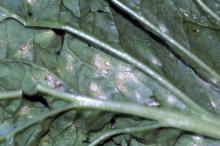Cause A fungus, Stagonosporopsis caricae (syns. Stagonosporopsis citrulli, Stagonosporopsis cucurbitacearum, Didymella bryoniae, Phoma cucurbitacearum), which overwinters in associaton with infected crop debris for at least two years. This fungus can also be seedborne. Numerous other cucurbits are affected, including cantaloupe, cucumber, squash, and pumpkin.


